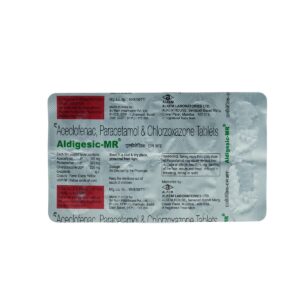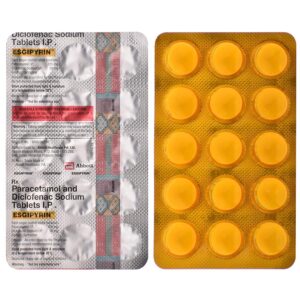PARACETAMOL + DICLOFENAC
Paracetamol: Paracetamol, also known as acetaminophen, is a commonly used over-the-counter pain reliever and fever reducer. It belongs to the class of drugs known as analgesics and antipyretics. Paracetamol is widely used to alleviate mild to moderate pain and reduce fever in conditions such as headaches, toothaches, muscle aches, colds, and flu.
The exact mechanism of action of Paracetamol is not fully understood. It is believed to work by inhibiting the synthesis of prostaglandins, which are chemicals involved in pain and fever signaling in the body. By reducing the production of prostaglandins, Paracetamol helps to lower pain levels and fever.
The recommended dose of Paracetamol for adults is usually 325 to 1000 mg every 4 to 6 hours as needed, with a maximum daily dose of 4 grams. For children, the dosage is based on their weight. It is important to follow the recommended dosage instructions and not exceed the maximum daily limit to avoid potential liver damage.
While Paracetamol is generally considered safe when taken at the recommended doses, it is not without side effects. Common side effects include nausea, stomach upset, and allergic reactions such as rash and itching. In rare cases, Paracetamol can cause liver damage when taken in excessive amounts or with alcohol. It is important to seek immediate medical attention if symptoms such as yellowing of the skin or eyes, dark urine, or abdominal pain occur after taking Paracetamol.
As with any medication, it is recommended to consult a healthcare professional or read the product label for specific instructions and precautions before using Paracetamol.
Diclofenac: Diclofenac is a nonsteroidal anti-inflammatory drug (NSAID) used to treat pain and inflammation in various conditions such as arthritis, muscle sprains, and menstrual cramps. It is available in multiple forms including tablets, capsules, topical gels, and injections.
The mechanism of action of diclofenac is through the inhibition of cyclooxygenase (COX) enzymes, specifically COX-1 and COX-2. COX enzymes play a role in the production of prostaglandins, which are substances involved in pain and inflammation. By inhibiting the COX enzymes, diclofenac reduces the production of prostaglandins, leading to pain relief and decreased inflammation.
The dosage of diclofenac depends on the formulation and the specific condition being treated. The usual oral dose for adults is 50-150 mg per day, divided into multiple doses. However, it is important to follow the instructions provided by the healthcare professional, as the dosing may vary based on individual factors such as the severity of the condition and the patient’s response to treatment.
Like all medications, diclofenac may cause side effects. The common side effects include stomach upset, diarrhea, dizziness, headache, and rash. These side effects are usually mild and temporary. However, some individuals may experience more serious side effects such as stomach ulcers, kidney problems, liver toxicity, allergic reactions, and cardiovascular events (e.g., heart attack or stroke). Therefore, it is crucial to notify a healthcare professional immediately if any unusual or severe side effects are experienced.
It is important to note that diclofenac is not recommended for individuals with a history of allergic reactions to NSAIDs, active stomach ulcers, bleeding disorders, severe heart failure, or kidney disease. Additionally, caution should be exercised when using diclofenac in elderly individuals, as they may be more prone to experiencing side effects.
As with any medication, it is advisable to consult a healthcare professional for proper evaluation and guidance on the use of diclofenac, including the correct dosage, potential interactions with other medications, and any specific precautions or contraindications based on individual medical history.


